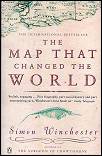
The Map That Changed the World : William Smith and the Birth of Modern Geology
1 journaler for this copy...
 * An exciting tale. Winchester is the perfect narrator for this lovely story of success against the odds. One leaves this book enlightened, moved and entertained [Spectator]
* An exciting tale. Winchester is the perfect narrator for this lovely story of success against the odds. One leaves this book enlightened, moved and entertained [Spectator]Amazon.com
Once upon a time there lived a man who discovered the secrets of the earth. He traveled far and wide, learning about the world below the surface. After years of toil, he created a great map of the underworld and expected to live happily ever after. But did he? Simon Winchester (The Professor and the Madman) tells the fossil-friendly fairy tale life of William Smith in The Map That Changed the World.
Born to humble parents, Smith was also a child of the Industrial Revolution (the year of his birth, 1769, also saw Josiah Wedgwood open his great factory, Etruria, Richard Arkwright create his first water-powered cotton-spinning frame, and James Watt receive the patent for the first condensing steam engine). While working as surveyor in a coal mine, Smith noticed the abrupt changes in the layers of rock as he was lowered into the depths. He came to understand that the different layers--in part as revealed by the fossils they contained--always appeared in the same order, no matter where they were found. He also realized that geology required a three-dimensional approach. Smith spent the next 20 some years traveling throughout Britain, observing the land, gathering data, and chattering away about his theories to those he met along the way, thus acquiring the nickname "Strata Smith." In 1815 he published his masterpiece: an 8.5- by 6-foot, hand-tinted map revealing "A Delineation of the Strata of England and Wales."
Despite this triumph, Smith's road remained more rocky than smooth. Snubbed by the gentlemanly Geological Society, Smith complained that "the theory of geology is in the possession of one class of men, the practice in another." Indeed, some members of the society went further than mere ostracism--they stole Smith's work. These cartographic plagiarists produced their own map, remarkably similar to Smith's, in 1819. Meanwhile the chronically cash-strapped Smith had been forced to sell his prized fossil collection and was eventually consigned to debtor's prison.
In the end, the villains are foiled, our hero restored, and science triumphs. Winchester clearly relishes his happy ending, and his honey-tinged prose ("that most attractively lovable losterlike Paleozoic arthropod known as the trilobite") injects a lot of life into what seems, on the surface, a rather dry tale. Like Smith, however, Winchester delves into the strata beneath the surface and reveals a remarkable world. --Sunny Delaney --This text refers to the Hardcover edition.
Book Description
In 1793, a canal digger named William Smith made a startling discovery. He found that by tracing the placement of fossils, which he uncovered in his excavations, one could follow layers of rocks as they dipped and rose and fell -- clear across England and, indeed, clear across the world -- making it possible, for the first time ever, to draw a chart of the hidden underside of the earth. Determined to expose what he realized was the landscape's secret fourth dimension, Smith spent twenty-two years piecing together the fragments of this unseen universe to create an epochal and remarkably beautiful hand-painted map. But instead of receiving accolades and honors, he ended up in debtors' prison, the victim of plagiarism, and virtually homeless for ten years more. Finally, in 1831, this quiet genius -- now known as the father of modern geology -- received the Geological Society of London's highest award and King William IV offered him a lifetime pension.
The Map That Changed the World is a very human tale of endurance and achievement, of one man's dedication in the face of ruin. With a keen eye and thoughtful detail, Simon Winchester unfolds the poignant sacrifice behind this world-changing discovery.
[From AMAZOM again:]
Winchester is beginning to make a habit of writing stories bringing to light forgotten people making important discoveries and doing important work that has changed our world. I hope it is a habit he continues. I am already looking forward to the next gem he digs up. He and Dava Sobel are a one-two punch of brilliant modern writing on scholars and scientists who deserve to be remembered.







